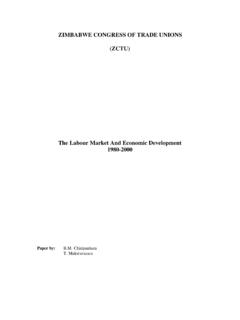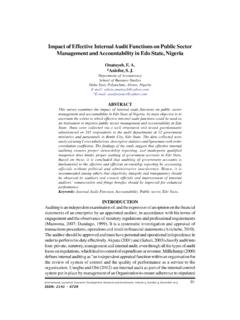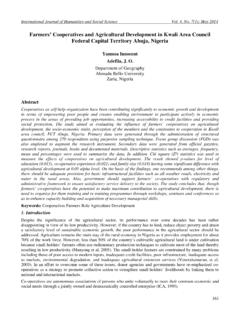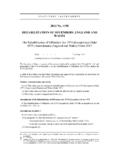Transcription of THE PRIVATISATION PROCESS AND ITS IMPACT ON SOCIETY
1 UGANDA NATIONAL NGO FORUM STRUCTURAL ADJUSTMENT PARTICIPATORY REVIEW INITIATIVE (SAPRI) THE PRIVATISATION PROCESS AND ITS IMPACT ON SOCIETY JULY 2001 Prepared By: J. Ddumba-Ssentamu & Adam Mugume Makerere University Institute of Economics ii TABLE OF CONTENTS Table of ii List of iv List of v List of vi Executive viii 1 Objectives of the 3 Terms of 3 4 The 4 Literature 6 Sampling Limitations and Data 7 Data 7 The Pre-Reform 8 Evolution and Performance of State-Owned 8 The Reform 10 Evaluation of the Privatization 12 Peoples Understanding of the Privatization 12 Economic 13 Fiscal 16 Socio-Political The Management of the Divestiture 19 Workers Participation in
2 The Formulation and Implementation of the Policy 26 Enterprise 26 Capacity 26 Sales 27 27 Product 28 29 29 29 Total 29 Gender Pattern of 30 32 Remuneration Levels, Wages and Working 33 Employment 33 iii Ownership 34 Cost-Benefit Analysis of Financial 37 Social 37 39 Fiscal IMPACT of Privatization PROCESS And 41 Fiscal IMPACT of The Utilization of Divestiture Summary of the 47 Conclusion and Policy 49 49 Policy 51 53 Appendix I Questionnaire; Survey of Privatized Appendix II Qualitative Assessment of the Privatization PROCESS in 57 Appendix III Uganda: Capacity Utilization in Privatized Companies 59 Appendix IV Uganda: Sales Revenue in Privatized Companies 60 Appendix V Uganda: Profits in Privatized Companies 61 Appendix VI Uganda: Investment in Privatized Companies 62 Appendix VII Uganda: Taxes in Privatized Companies 63 Appendix VIII Uganda.
3 Employment in Privatized Companies 64 Appendix IX Divestitures Completed as at September 65 iv List of Tables Table 1 Returned 5 Table 2 Ownership of 10 Table 3 Responses Vis- -vis the achievement of the Economic 14 Table 4 Responses Vis- -vis the achievement of the Fiscal 16 Table 5 Responses Vis- -vis the achievement of the Socio-Political 17 Table 6 Uganda: Classifications of PEs 21 Table 7 Uganda: Method of sale used during the divestitures completed by September 23 Table 8 Uganda: Gender Composition of Employment 1993-1999 .. 32 Table 9 Uganda: Privatized Enterprises by form of Ownership 35 Table 10 Uganda: Divestiture by form of Ownership 35 Table 11 Uganda: Budgetary Breakdown for EDP credit and local counterpart 38 Table 12 Uganda: Public Sector Subsidies from Government 42 Table 13 Proceeds of Divestiture and their Utilization 45 Table 14 Uganda: Operations of the Divestiture Account 46 v List of Figures Figure 1 Uganda: Selected Privatization Performance Indicators 28 Figure 2 Divestiture Proceeds by form of Ownership 36 Figure 3 Number of firms by Ownership 36 Figure 4 Uganda.
4 Trends in different types of Subsidies from Government 43 vi List of Acronyms ASAC - Agricultural sector Adjustment Credit BAT - British American Tobacco CMB - Coffee Marketing Board DAP - Divestiture Action Plan DAPCB - Departed Asian Property Custodian Board DRIC - Divestiture and Reform Implementation Committee EDP - Enterprise Development Project ENHAS - Entebbe Handling Services ERP - Economic Recovery Program GDP - Gross Domestic Product IDA - International Development Association IGG - Inspector General of Government LMB - Lint Marketing Board MFEPED - Ministry of Finance, Planning and Economic Development NIC - National Insurance Corporation NOTU - National Organization of Trade Unions NRC - National Resistance Council NTB - National Textile Board NTC - National Tobacco Corporation NYTIL - Nyanza Textile Industrial Ltd.
5 PERD - Public Enterprise Reform and Divestiture PERDS - Public Enterprise Reform and Divestiture Secretariat PES - Public Enterprise Secretariat PIES - Public Industries Enterprises Secretariat PMB - Produce Marketing Board PRWG - Policy Review Working Group PSF - Private Sector Foundation SAPs - Structural Adjustment Programs SOEs - State Owned Enterprises vii TUMPECO The Uganda Metal Products and Enameling Company UCB - Uganda Commercial Bank UCC - Uganda Cement Corporation UCCI - Uganda Chamber of Commerce and Industry UCDA - Uganda Coffee Development Authority UCS - Uganda Consumer SOCIETY UDB - Uganda Development Bank UDC - Uganda Development Corporation UDN - Uganda Debt Network UGMC - Uganda Grain Milling Company UEB - Uganda Electricity Board UFEA - Uganda Farmers and Exporters Association UIA - Uganda Investment Authority UMA - Uganda Manufacturers Association UMSC - Uganda Muslim Supreme Council UPE - Universal Primary Education UPTC - Uganda Posts and Telecommunication USC - Uganda Steel Corporation URC - Uganda Railways Corporation UTA - Uganda Tea Authority UTL - Uganda Telecom Limited viii EXECUTIVE SUMMARY Uganda
6 Embarked on the PRIVATISATION of formally SOEs in 1993 and is continuing with the PROCESS with 34 SOEs remaining to be privatised out of 139. Although PRIVATISATION was intended to result into fiscal benefits and equity-enhancing effects through income distribution effects, reduction of inequalities in access to goods and services by limiting opportunities for favouritism, corruption and differential fixing of rents that penetrate economies with extensive state controls and subsidies, there are concerns that PRIVATISATION has hurt the socio-economic welfare of the majority.
7 Civil SOCIETY concerns are that benefits have gone almost entirely to the mangers of the PROCESS . There is a feeling that government has not facilitated adequate participation of the locals in the PROCESS , thus the locals feeling robbed of national assets that were built through accumulation of taxpayers' contributions. This report presents the findings of a study that was commissioned by SAPRI (Uganda) aimed at assessing the IMPACT of PRIVATISATION on SOCIETY . Its major findings and conclusions are three. First, that given the appalling state of SOEs in Uganda, and its negative effects on the economy, PRIVATISATION was the most ideal choice for government.
8 Second that despite this, there is contention that the PROCESS has been poorly managed and that the timing and sequencing of the program were not proper. There was lack of an appropriate institutional framework to facilitate the PROCESS . A number of SOEs were undervalued and more money was spent on preparing and restructuring the enterprises for divestiture than has been realised from the sales. Although the utilisation of the divestiture proceeds has been provided publicly, there is discontent about valuation of net-worth of SOEs privatised and collection of the proceeds.
9 For example, by the end of 1993, only 28 out of 55 enterprises sold out, that is 51 percent, had been fully paid for. The study further finds that large proportions of people interviewed were fairly well informed about the program. However, their understanding of PRIVATISATION in Uganda is ix that it is a sale of SOEs that was imposed on the country by the Brettonwoods institutions to enrich government officials, give foreign investors windfall profits as a way of re-colonisation period! According to many, no provisions, were put in place for an employee preference scheme to increase opportunity to acquire ownership on favourable terms whether in form of shares, purchase of physical assets or 100 percent buy-out.
10 Third, that the IMPACT of PRIVATISATION on SOCIETY is mixed but with lessons to draw for post SAPRI recommendations. IMPACT on SOCIETY The study found that there is consensus on the following two issues: 1. That PRIVATISATION has led to increased supply of quality goods and services on the market especially essential commodities (sugar, salt, soap, ) that were in short supply and a monopoly of SOEs in production and distribution. 2. That PRIVATISATION has led to increased industrial capacity utilisation, profitability and higher employment levels in the privatised enterprises.









